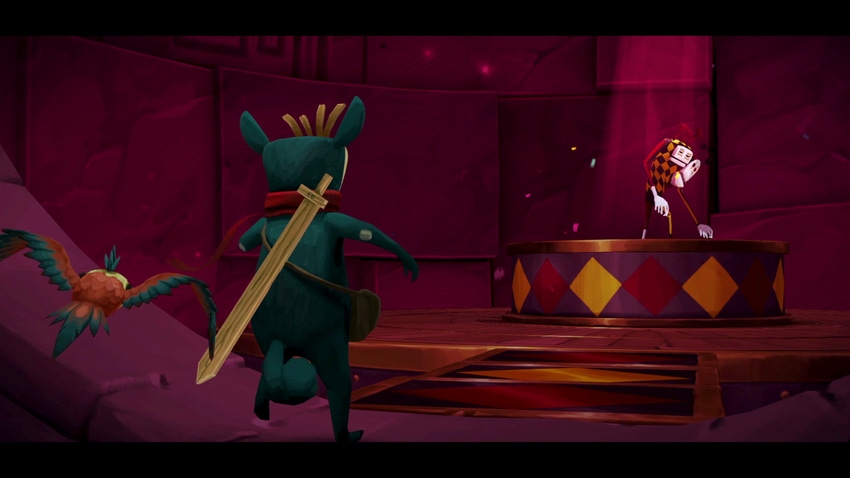There aren't a lot of strong models out there for "sidekick mode," as the designers put it. But, with their own kids in mind, they set out to make it anyway.

Game Developer Deep Dives are an ongoing series with the goal of shedding light on specific design, art, or technical features within a video game in order to show how seemingly simple, fundamental design decisions aren’t really that simple at all.
Earlier installments cover topics such as the scientific modeling behind the irrigation and water systems of Timberborn, how the 2D art of Songs of Glimmerwick benefited from a 3D art pipeline, and how the synergy between art and audio disciplines and a solid base of real-world data formed a surprisingly faithful televised broadcast experience in F1 Manager 2022.
In this edition, two key developers tell us about the motivations and mechanisms behind the co-op feature in Figment 2.
Hello! We are Klaus Pedersen (CEO) and Niels Højgaard Sørensen (game and audio director) from Bedtime Digital Games, based in Aalborg, Denmark. We’re a small award-winning studio, having previously developed and self-published three titles: Back to Bed, Chronology, and Figment. We recently ventured into publishing and our first was The Forest Quartet, a game about life, death, and jazz.
For the past couple of years, we’ve been working on Figment 2: Creed Valley, an action-adventure game set in the human mind, where you play as Dusty—courage incarnate—and must face nightmares in musical showdowns.
Figment 2 is improving and expanding the franchise in a lot of different ways, but the largest is the addition of a co-op mode, in opposition to Figment 1, which is a strictly single-player game. The co-op feature was implemented due to a recurring theme found in the numerous messages we received from players over the years: A lot of parents were playing Figment with their children, some had their kids watching, others passed the controller around, but in the end, it was very obvious that the parents writing the emails felt that Figment had offered them an experience that both adults and kids enjoyed.
As the Figment universe was created to be safe for kids to play, but also offer a challenge and a layered story that would appeal to adults, it was nice to see that the game struck a chord with families. However, that so many would play the game sitting next to their kids and bond over the characters and story was a pleasant surprise.

Following this, we decided naturally to make Piper, Dusty's ever-optimistic sidekick, a playable character. However, she is intentionally designed to be more of a sidekick to Dusty. She won’t be able to take damage and is not required to do specific things for the game to progress. Instead, she supports Dusty by picking up health orbs, blocking shots, and distracting enemies.
Having these features for Piper has benefited the co-op experience more than we had anticipated. On paper, you think of it as another character able to interact within the world, albeit in a lesser way than Player 1 can. However, when playing through the game with your kid it changes everything: My son and I playtested an early version of the feature and it was fun to watch him fly around, keeping his eyes peeled for any enemies to “protect [me] from danger,” and rooting for me during the boss fights. It also allowed me to see the game through his eyes, and how he perceived the Figment universe and all its inhabitants.
Throughout the design process of the ‘sidekick mode’, we paid close attention to how other games had approached similar features, only to discover very few do it. Most notable is perhaps the ability to play Cappy in Super Mario Odyssey. You see people talking about it from time to time, and every time it’s with praise, which makes you think that the feature would be more prevalent. Perhaps it’s time for the gaming industry to embrace that we now have an audience of gamers that grew up playing PlayStation 1 and N64 titles in the '90s, and who are starting to have kids themselves. Now, they don’t see video games as a way to get a break from their surroundings or responsibilities; they want to play games with their kids.
In the end, the sidekick co-op feature has been designed to be suitable when playing with a 4 to 8-year-old. The player controlling Piper is not burdened with carrying the game forward, they can’t interact with puzzles, buttons, or switches. We found this to be essential in defining the parameters for the type of co-op we envisioned for Figment 2, and we hope will lead to a great shared gaming experience.
But what if you want to play Figment 2 with your kid that is now 8+ years old and has lots of gaming experience? Well, maybe it’s time for the parents to take on the sidekick role, and support their kids' hobbies and help them overcome some nightmares, like in the game.

We’re incredibly proud of what Piper has become in Figment 2. She’s gotten a complete overhaul in both her design and abilities. We think that players will enjoy how the two characters interact with each other and how their responsibilities intertwine in fleshing out the narrative.
About the Author(s)
You May Also Like







